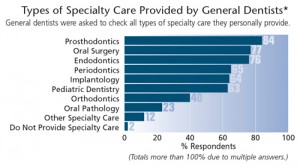Specialty Care In the General Dental Practice
Thanks to a combination of factors — including patient demand, technology, and the fact that multidisciplinary care not only adds fresh revenue streams, but also attracts new patients — general dentists are providing more specialty care than ever.

Thanks to a combination of factors — including patient demand, technology, and the fact that multidisciplinary care not only adds fresh revenue streams, but also attracts new patients — general dentists are providing more specialty care than ever. In fact, research confirms that 98% of general practitioners (GPs) surveyed for the study provide one or more types of specialty care.*
What types of specialty services are most popular among GPs? And which specialties do they consider as growth areas? While you might expect a strong correlation in the responses to these questions, that’s not true in all categories. While implantology and orthodontic treatment rank fifth and seventh on the specialty services list, for example, they’re seen as the first and fourth most important growth opportunities. And while oral surgery ranks as the second most common specialty procedure provided by general dentists, it falls to sixth in perceived growth potential.

Of the dentists surveyed, 84% perform prosthodontic procedures. This makes sense, since restorative care is the bread and butter of most offices, and the line isn’t always clearly defined between general restorative treatment and prosthodontic care. Oral surgery and endodontic therapy are also commonly offered by GPs, and, at 77% and 76%, respectively, are neck and neck in terms of specialty services provided.
Periodontics, implantology and pediatrics are the next most common specialty services delivered in general dental settings, with 65%, 64% and 63% of respondents providing these types of procedures. With large numbers of patients presenting with periodontal conditions, providing treatment in the dental home is convenient for patients and a natural practice builder. Patients are retaining more of their natural dentition into their later years and wish to maintain function, and this presents opportunity for both periodontal and implant treatment — all within the practitioner’s professional comfort zone, of course. As for pediatric dentistry, this is a natural part of family practice. And with increasing numbers of pediatric patients expected as a result of health care reform, this represents an obvious growth opportunity.
In a trend that’s likely supported by invisible aligner systems, 40% of the GPs surveyed now offer orthodontic treatment, while oral pathology (23%) and “other” specialty care (12%) round out the list of specialty services provided. Based on this data and dentists’ expectations for growth opportunities, look for multidisciplinary care to play an even greater role in future practice.
*Independent research by Martin Akel & Associates of Nipomo, California.


